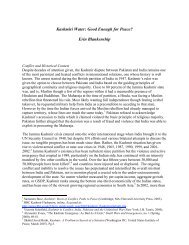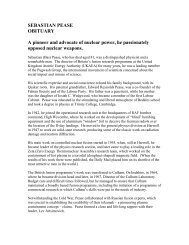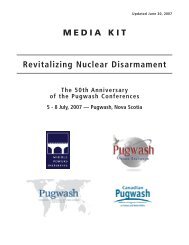Eliminating Stockpiles of Highly Enriched Uranium - Pugwash ...
Eliminating Stockpiles of Highly Enriched Uranium - Pugwash ...
Eliminating Stockpiles of Highly Enriched Uranium - Pugwash ...
You also want an ePaper? Increase the reach of your titles
YUMPU automatically turns print PDFs into web optimized ePapers that Google loves.
Further de-enrichments to make commercial fuel out <strong>of</strong> the LEU will have to be paid<br />
for by Minatom. This would have the advantage <strong>of</strong> creating tight borders between<br />
what the donors and Russia do for security reasons and what Russia does for<br />
commercial reasons at a later stage. Furthermore, with this scheme it might be<br />
possible to reduce the costs for the Russian down-blending services.<br />
Another flexibility could be added by negotiating paying for Russian HEUoriginated<br />
fuel not by financial transfers from donor states, but by deducting existing<br />
Russian state debt to would-be donors. Possible “Debt for Nonproliferation Swaps"<br />
have been proposed at past G-8 Meetings. To Russian actors, such proposals may be<br />
attractive, but still have to be for further review.<br />
For the scheme to work, enough transparency should be provided by Russia to<br />
enable the outside world to verify that the production <strong>of</strong> new HEU has definitely<br />
stopped, and secondly, that the de-enriched HEU is properly measured, accounted for<br />
and safeguarded (possibly by the International Atomic Energy Agency).<br />
HEU elimination verification and transparency<br />
To build trust and avoid cheating and diversion <strong>of</strong> the HEU slated for elimination<br />
under an extended HEU deal, verification and transparency measures are essential.<br />
However, HEU verification is generally quite challenging, partly due to the physical<br />
properties <strong>of</strong> highly enriched uranium, and partly because <strong>of</strong> the sensitivity issues<br />
involved. Nevertheless, transparency and verification measures have been<br />
successfully implemented under the ongoing HEU-deal (see chapter 4). Important<br />
lessons could be drawn from this and other bilateral co-operation.<br />
Nuclear weapons components, shape, isotopic composition, and geometry is<br />
classified and/or sensitive information. This complicates measurements on HEU from<br />
nuclear weapons. Before any measurement technique can be accepted for use in an<br />
arms control agreement, all parties must agree upon its use. Experience has shown<br />
that the likelihood that an arms control technology will be accepted increases if the<br />
following is considered: 78<br />
- Measurements cannot reveal classified information<br />
- Simple technology is preferable to complex technology<br />
- Familiar technology is preferable to complex technology<br />
- Passive measurements are generally preferable to active interrogation<br />
measurements.<br />
All measures put in place should be as transparent as possible, thus the call for<br />
simplicity and familiarity. In the simplest cases, radiation emitted from the object <strong>of</strong><br />
interest can be measured directly, through passive measures. Active measurements<br />
collect and analyse the resulting radiation after neutron-bombardment for example.<br />
However, such measures may be too intrusive, thus violating the number-one<br />
principle <strong>of</strong> arms-control verification, i.e. not to reveal any classified information.<br />
78 Gosnell, T. B. 2000. <strong>Uranium</strong> Measurements and Attributes. The 41 st Annual Meeting <strong>of</strong> the Institute<br />
for Nuclear Material Management, and Preprint UCRL-JC-1394450, Lawrence Livermore National<br />
Laboratory, July 2000.<br />
30







